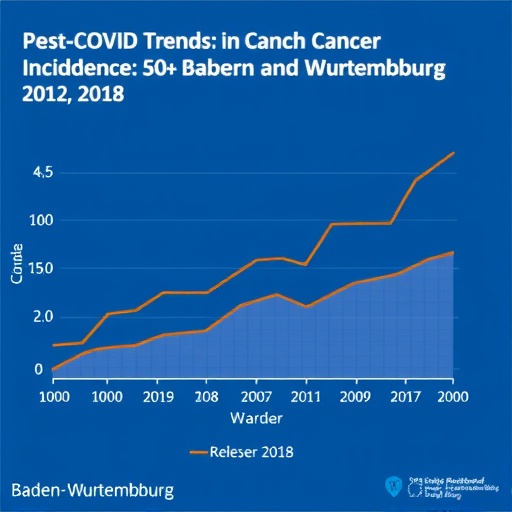At first glance, Alzheimer’s disease and cancer appear to be disorders at opposite ends of the health spectrum—one progressively deteriorates cognitive function, while the other aggressively invades bodily tissues. Yet, a groundbreaking study from researchers at the MUSC Hollings Cancer Center reveals an intricate biological interplay linking these seemingly distinct conditions. Published in the prestigious journal Cancer Research, the study uncovers novel mechanisms by which a protein traditionally implicated in Alzheimer’s pathology exhibits an unexpected role in bolstering immune system function, thereby impacting cancer susceptibility and immune aging.
For decades, epidemiological studies have presented a perplexing paradox: individuals diagnosed with Alzheimer’s disease exhibit a significantly reduced incidence of cancer compared to the general population. This intriguing observation caught the attention of Besim Ogretmen, Ph.D., associate director of Basic Science at MUSC Hollings Cancer Center. Driven to elucidate the underlying biology bridging Alzheimer’s and cancer, Ogretmen and colleagues embarked on a comprehensive investigation that combined epidemiology with molecular and cellular biology.
A rigorous analysis by epidemiologist Kalyani Sonawane, Ph.D., and her team, scrutinizing five years of nationally representative survey data, confirmed the statistical robustness of the Alzheimer’s-cancer inverse relationship. Their findings revealed that adults over 59 years of age suffering from Alzheimer’s disease were 21 times less likely to develop cancer than age-matched controls without Alzheimer’s. While this data fortified the epidemiological link, the biological mechanisms behind this correlation remained obscure.
Delving into cellular pathways, the research team focused on amyloid beta, a peptide peptide long associated with neuronal toxicity and cognitive decline in Alzheimer’s disease. Traditionally, amyloid beta accumulation in the brain is recognized as a pathological hallmark, leading to synaptic dysfunction and neurodegeneration. However, the new study identified a dualistic nature of this protein: while it derails neuron function, amyloid beta simultaneously enhances the vigor of immune T-cells, key players in anti-tumor immunity.
Central to their discovery is the role of amyloid beta in modulating mitophagy, a selective autophagic process essential for the degradation and recycling of damaged mitochondria in cells. In neurons, amyloid beta impairs mitophagy, causing dysfunctional mitochondria to accumulate. These defective mitochondria generate oxidative stress and toxic metabolites that expedite neuronal injury and cognitive impairment characteristic of Alzheimer’s disease. This blockade of mitochondrial clearance represents a critical pathogenic event.
In stark contrast, amyloid beta exerts a reparative effect on the immune system’s cytotoxic T-cells. By inhibiting mitophagy within these immune cells, the peptide preserves mitochondrial integrity, ensuring sustained energy production critical for T-cell activation and function. The retention of functional mitochondria in T-cells translates to heightened immune surveillance capacity, thereby enhancing anti-tumor immunity. This finding uncovers a biological trade-off: amyloid beta’s detrimental effects on neurons are counterbalanced by its protective rejuvenation of T-cell populations.
The research team experimentally validated their hypothesis by performing mitochondrial transplantation from Alzheimer’s-affected T-cells into aged, non-Alzheimer’s T-cells. Remarkably, these older T-cells exhibited restored metabolic and functional phenotypes comparable to youthful immune cells. This metabolic reactivation underscores a profound potential therapeutic avenue whereby mitochondrial transfer could revitalize aging immune cells, augmenting their capacity to detect and eliminate cancer cells.
Fumarate, a mitochondrial metabolite pivotal in cellular energy metabolism, emerged as another crucial factor in this biological interplay. Under normal circumstances, fumarate acts as a regulatory checkpoint, modulating the extent of mitophagy by binding specific regulatory proteins and restraining excessive mitochondrial degradation. The study demonstrated that amyloid beta contributes to fumarate depletion, which unleashes unregulated mitophagy, risking the loss of healthy mitochondria and attenuating cell strength, especially within immune T-cells.
Pharmacological restoration of fumarate levels in aging T-cells produced promising results. Supplementation with fumarate effectively reduced mitophagy rates, conserving mitochondrial mass, and revitalizing the energetic capacity of immune cells. These enhanced T-cells showed increased anti-tumor activity in both murine models and human tissue samples. Fumarate supplementation thus represents an adjunctive strategy to bolster immune function, particularly in the context of aging and immunosenescence.
The findings elegantly knit together epidemiological observations with cellular and molecular mechanisms, offering a comprehensive explanation for why Alzheimer’s patients are less prone to developing cancer. Rather than serving as a direct anti-cancer agent, amyloid beta indirectly enhances tumor immunosurveillance by preserving mitochondrial function within T-cells, recharging immune defenses compromised by aging.
This paradigm shift has far-reaching implications for oncology and gerontology alike. Therapeutic strategies capitalizing on mitochondrial transplantation could reinvigorate T-cell mediated immunity, potentially improving outcomes in cancers currently treated with immunotherapies such as CAR-T cell therapy. Furthermore, fumarate-based interventions might extend the functional longevity of immune cells, sustaining their anti-tumor vigilance throughout treatment courses and into advanced age.
Beyond oncology, these insights hint at broader applications for mitigating immune system decline associated with aging, which increases vulnerability to infections and chronic diseases. Unlocking the dualistic functions of amyloid beta also opens avenues for novel Alzheimer’s therapies that selectively harness its immune-boosting benefits while mitigating neurotoxicity, a complex but promising challenge in neurodegenerative research.
Besim Ogretmen emphasized the collaborative nature of this breakthrough, highlighting the convergence of expertise spanning cancer biology, immunology, and epidemiology at MUSC Hollings Cancer Center. This cross-disciplinary approach not only unraveled an unexpected biological paradox but also demonstrated how fundamental insights into one pathological process can illuminate innovative therapeutic strategies for entirely different diseases.
This study stands as a testament to the evolving understanding of Alzheimer’s and cancer as interconnected phenomena rather than isolated pathologies. By unmasking the mitochondrial mysteries underlying amyloid beta’s contradictory roles, the research paves the way for novel interventions that could revolutionize treatment for cancer, aging, and neurodegenerative diseases alike.
Subject of Research: Human tissue samples
Article Title: Alzheimer’s Disease-Associated Amyloid Beta Precursor Protein Prevents Aging Stress-Induced Mitophagy and Fumarate Depletion to Improve Anti-Tumor Immunity
News Publication Date: 1-Oct-2025
Web References:
Cancer Research Article DOI
Image Credits: Medical University of South Carolina
Keywords: Cancer, Alzheimer disease, Mitochondria, Ceramide signaling, Mitophagy
Tags: aging population health studiesAlzheimer’s disease and cancer connectionAlzheimer’s pathology and immune responseAlzheimer’s protein role in cancercancer susceptibility in Alzheimer’s patientscognitive decline and cancer incidenceepidemiological studies on Alzheimer’s and cancerimmune aging and Alzheimer’s diseaseimmune system function in cancerinterdisciplinary research in healthMUSC Hollings Cancer Center findingsnovel cancer treatment insights





